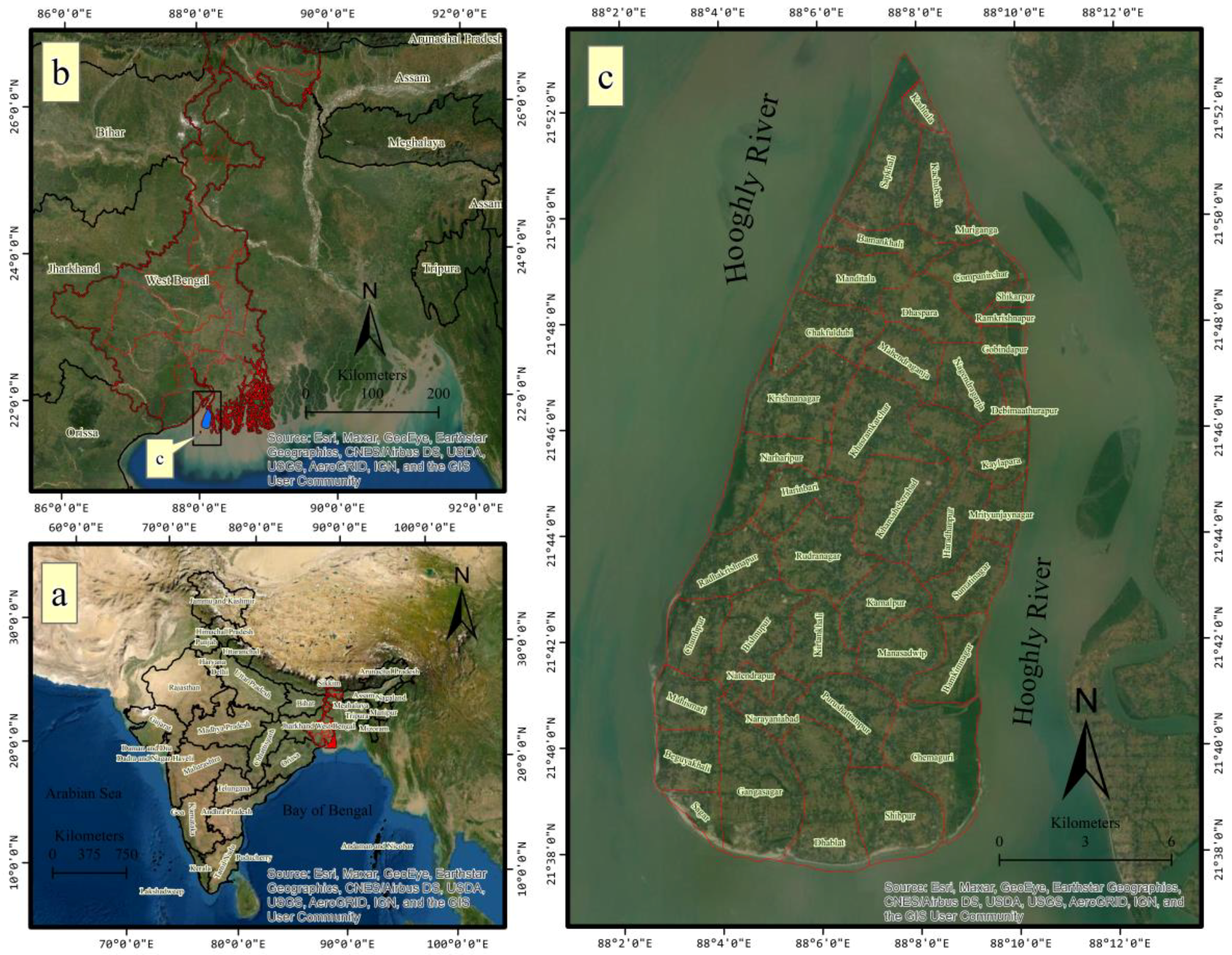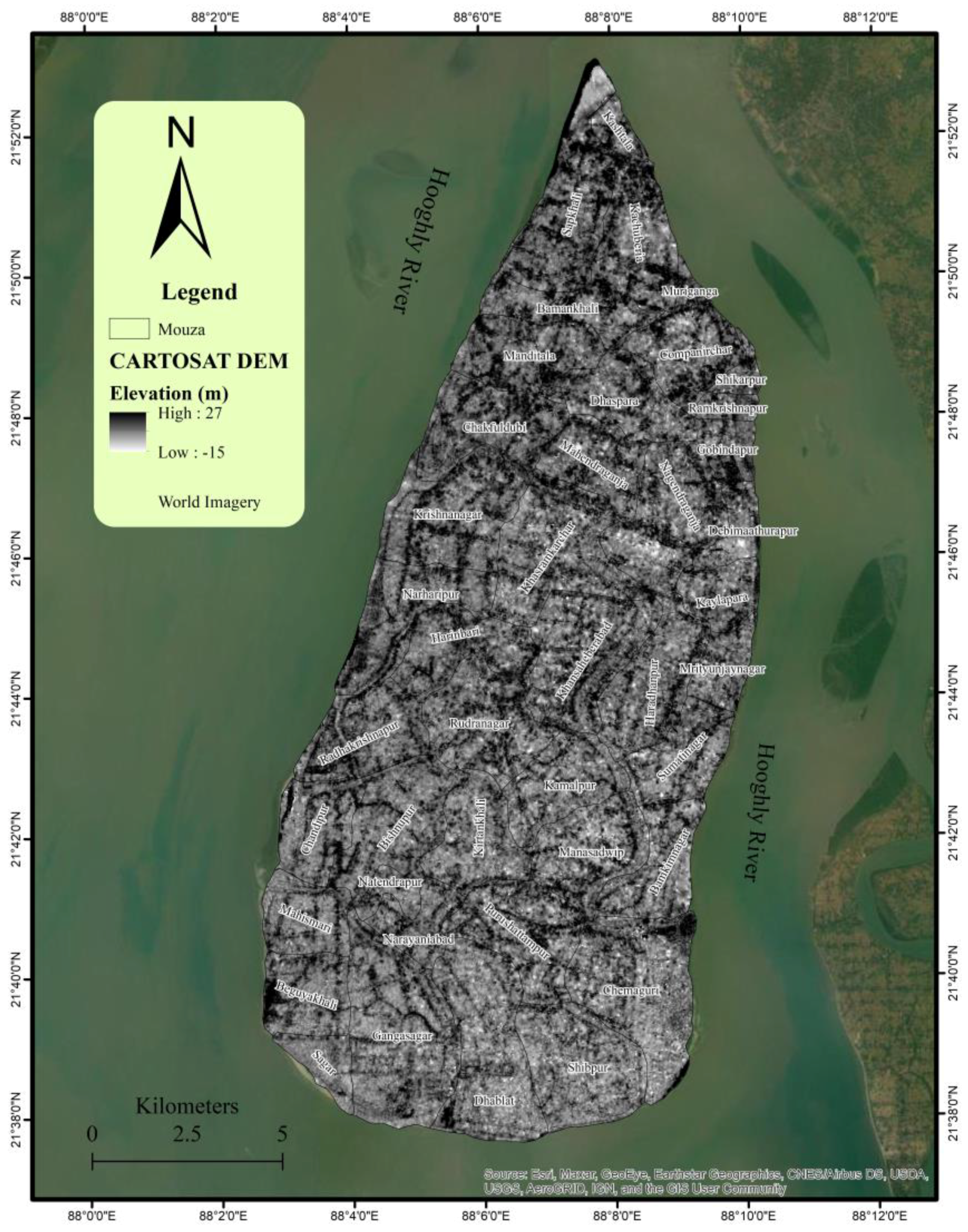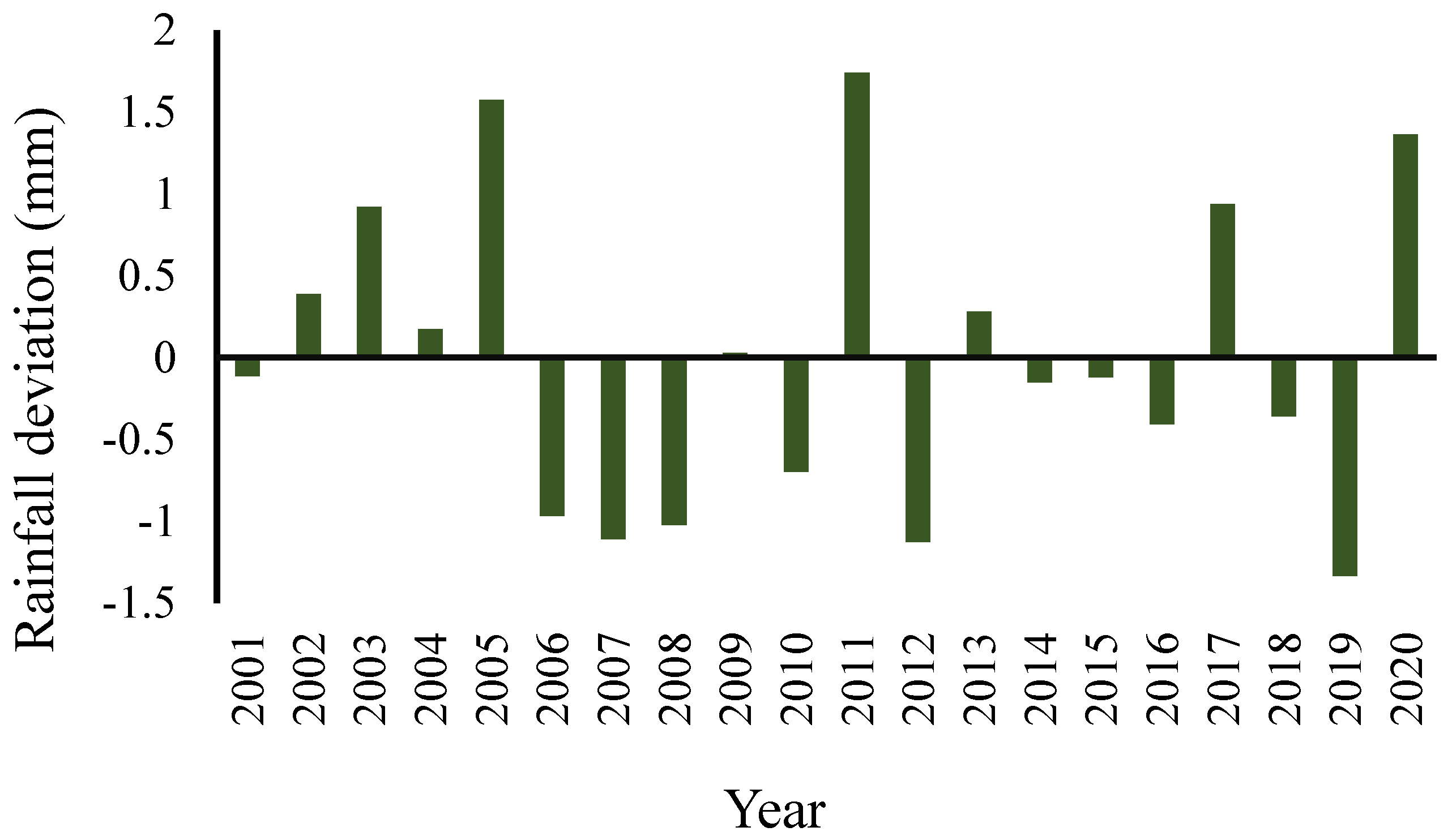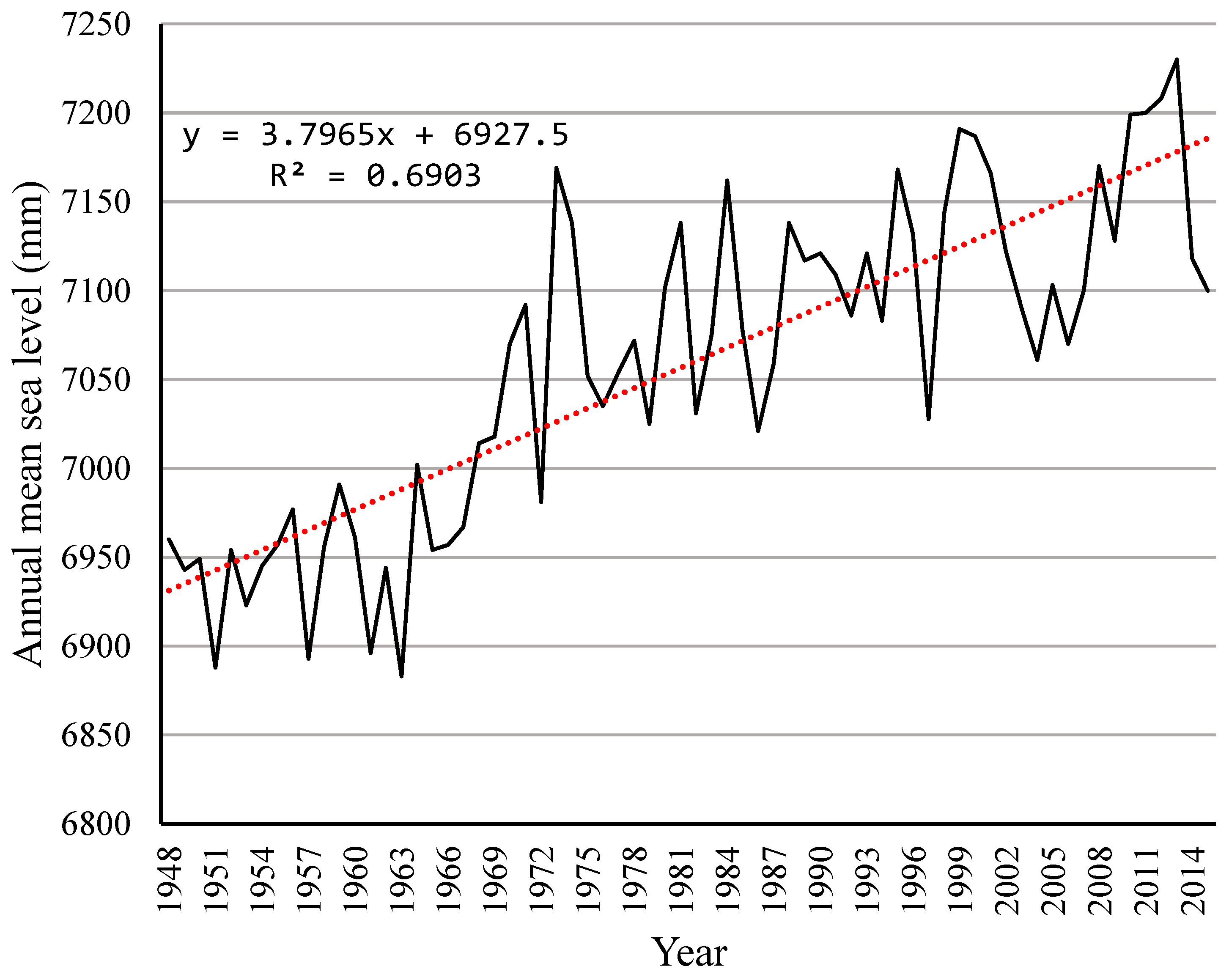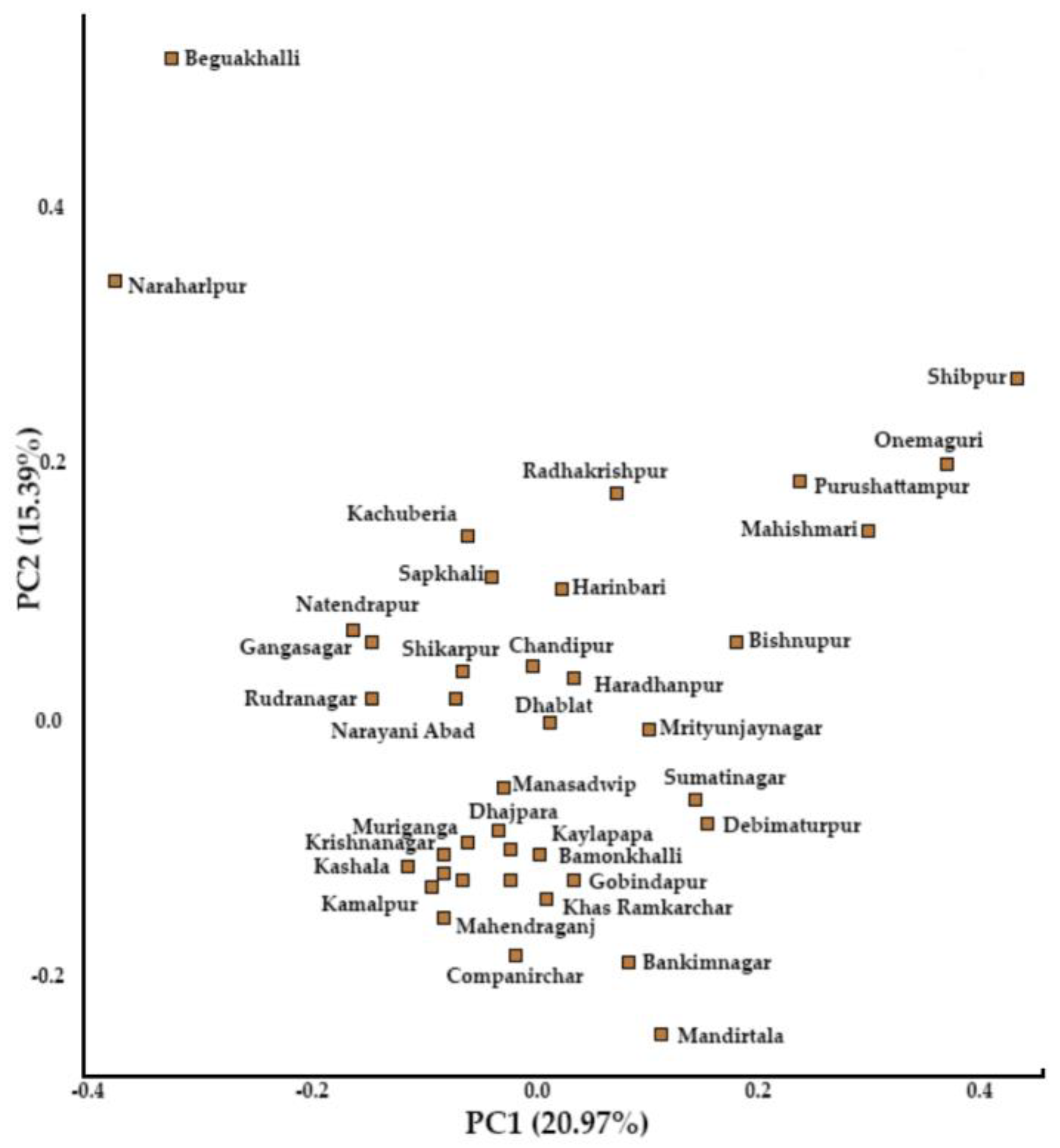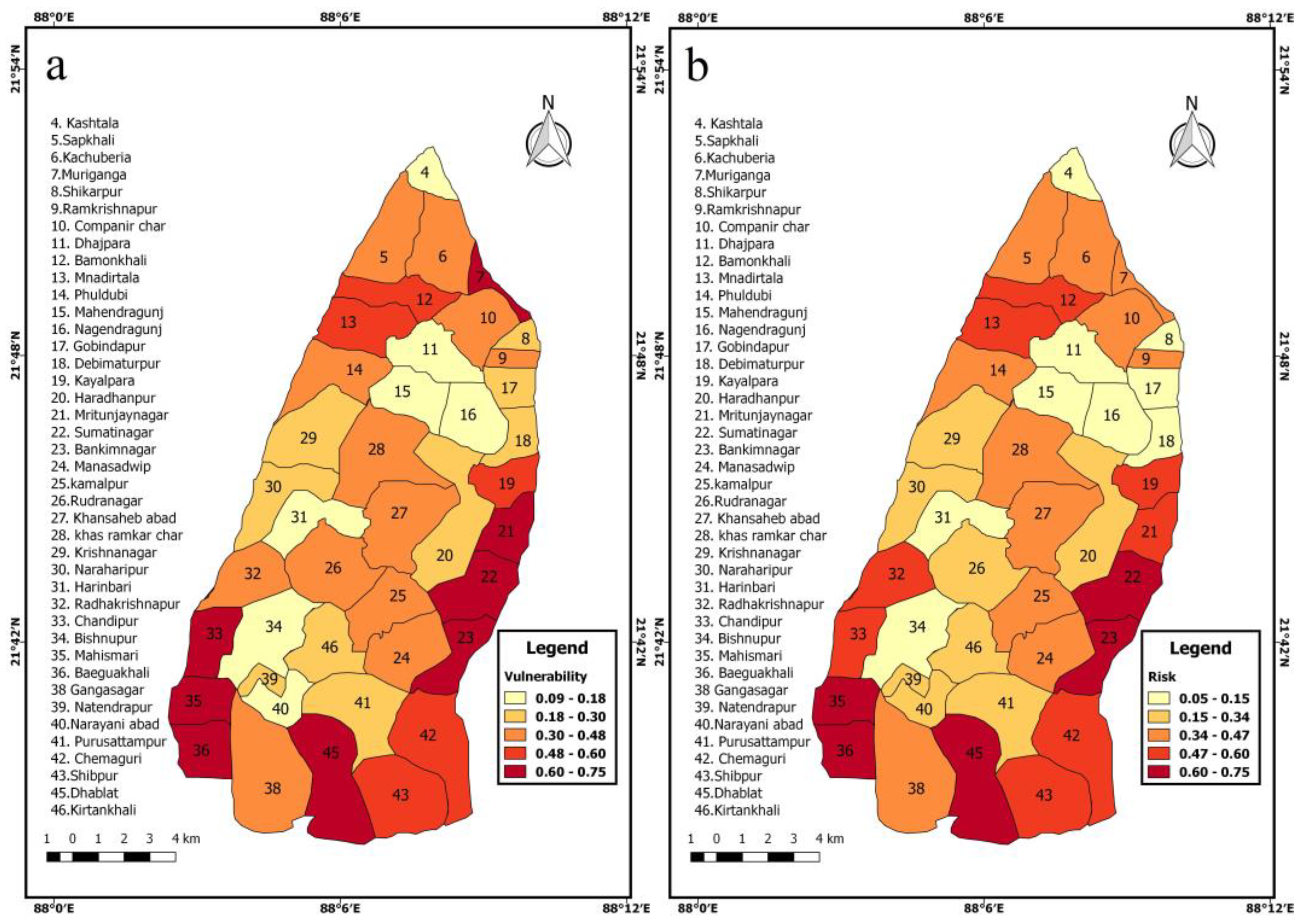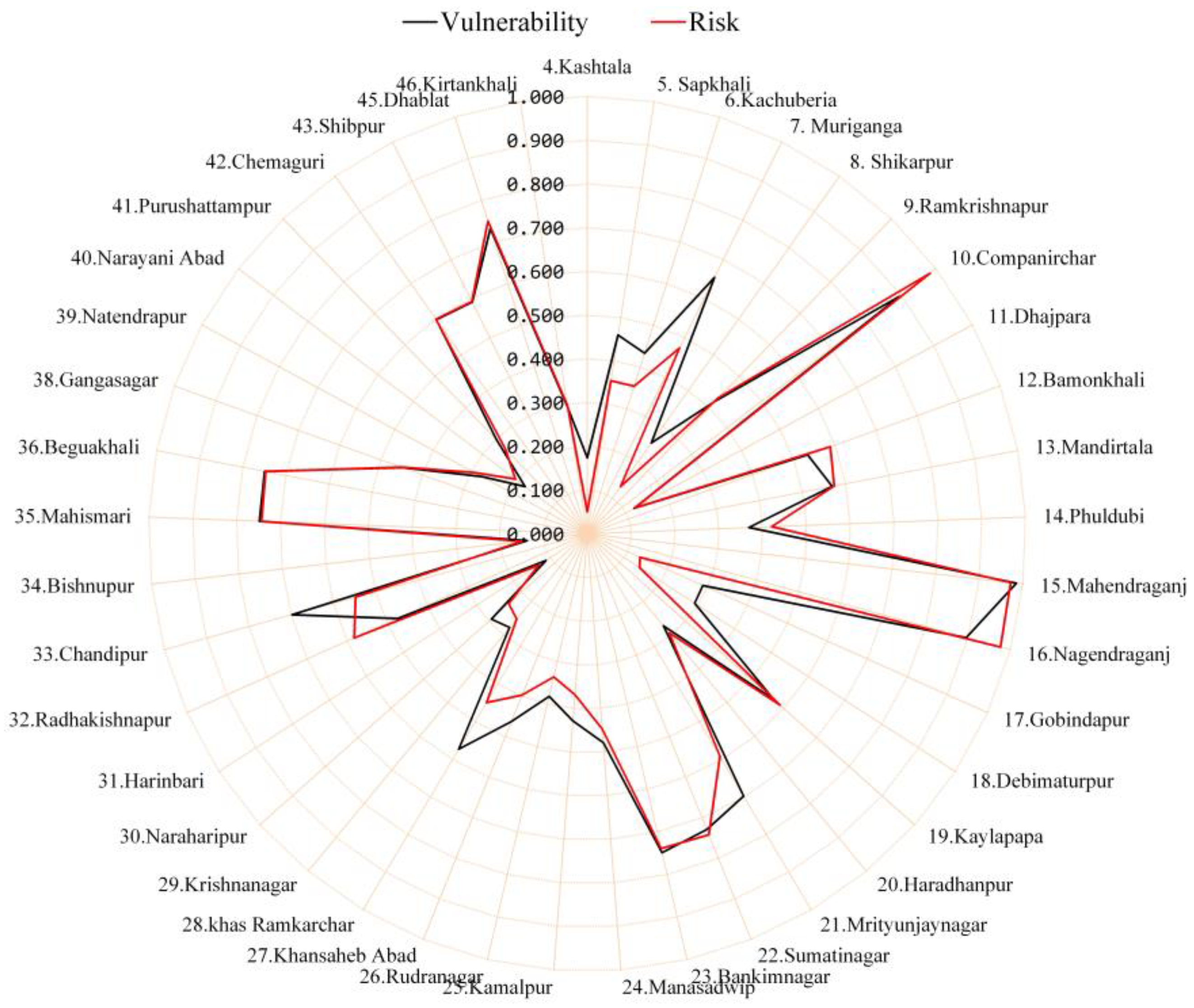1. Introduction
Climate change is a major concern that has increased the rapid and slow onset of climate events globally [
1,
2]. Rising ocean and air temperatures, increasing occurrence and intensity of tidal surges, violent stormy cyclones, severe flooding, and extreme precipitation events are some of the manifestations of climate change [
3]. The low-lying coastal regions are witnessing adverse impacts, such as inland flooding, submergence, and coastal erosion, due to rising sea levels [
4]. According to an estimation, by 2050, almost a million people living in three significant deltas, namely, the Mekong Delta, Nile delta, Ganges–Brahmaputra–Meghna delta, will be adversely impacted by rising sea levels [
5]. For the Indian Bengal Delta, such an increase could be as high as 70% [
6]. Climate variability greatly influences the environment and socioeconomic aspects, such as agriculture, livelihood, health, and biodiversity [
7]. Biophysical vulnerability manifests in communities’ exposure to climate change; hence, due to the greater social vulnerability, they are more exposed to adverse impacts [
8]. Climate change primarily affects the poor, disabled, aged, and marginalized populations, increasing social vulnerabilities [
9].
Apart from broad-scale increases, local factors influence household-level vulnerability [
10]. Population pressure, changes in land use, and intensive agriculture can exacerbate risks and exposure [
11]. These catalyze the displacement of endangered people and increase the number of population traps, which can cause internal and external population movement [
12,
13]. Sundarbans is a very good instance of the manifestations of climate change, wherein underdevelopment and over-reliance on climate-dependent subsistence have rendered the whole ecosystem vulnerable [
14].
Sagar Island has encountered the impacts of climate change in the form of rising sea levels, tidal surges, increased soil salinity, violent cyclones, and severe coastal erosion [
15,
16]. Part of an archipelago of 102 islands in the Sundarban coastal region, Sagar Island is the most significant. Its inhabitants are losing their land under their feet day by day. The surrounding four islands, named Bedford, Lohachara, Khasimara, and Suparivanga, were diluviated by coastal erosion in the last few decades. Bishalakkhipur mouza of Sagar Island was submerged, and Sagar mouza has become uninhabitable due to the excessive erosion. Ghoramara island will soon be submerged by the rising sea and accelerating erosion [
17]. The range of apparent sea level increase varies between 3–8 mm/year in the Sundarbans, beyond the global average of 3 mm/year [
18]. This present rate can result in a 20 percent enhanced flooding risk, over 1.520 mm by 2070 [
19]. According to [
18], the Indian Sundarban has lost approximately 4% of forest cover, a natural buffer against cyclone surges. Increasing sea levels and accelerated wave action caused subsequent changes in the hydrodynamic regime that led to severe land loss. From 2009 to 2019, the island’s area has prominently reduced from 246.76 km
2 to 230.98 km
2; the average decadal percent change in this area for that period accounted for −11.33% [
20]. The Bay of Bengal typically experiences 7% of the significant cyclones worldwide, while in the last 120 years, the frequency and intensity of the cyclones have increased between 20% and 26% [
21]. Severe cyclones, i.e., Yash (2021), Amphan (2020), Bulbul (2019), and Aila (2009), accompanied by storm surges and flooding, caused large-scale devastation to the coastal regions [
22]. The agricultural community depends solely on nature; extreme weather events, cyclone surges, tidal ingression, embankment breaching, saline water intrusion deplete their habitats and livelihoods, forcing them to become environmental refugees [
23].
Researchers worldwide are assessing the impacts of climate change, associated vulnerabilities, and risks due to the frequency, magnitude, and tenacity of climate events [
24,
25]. Globally, research on the human effects associated with climate change and their scale [
26] has been used to guide policymaking, with the demarcation of vulnerable areas and the identification of at-risk populations being made according to environmental assessments, along with the introduction of measures aimed at mitigating the impacts of severe climate events [
27,
28]. Ways to assess risk and vulnerability to the impacts of climate change have been defined by the Inter-Governmental Panel for Climate Change. As of the time of writing, two methodologies have been proposed, one based on the AR4 report and the most recent based on the AR5. As defined by the IPCC (2007), vulnerability is a function of sensitivity, exposure, and adaptive capacity [
29]. However, the terminology of risk, as introduced in the fifth Assessment Report (AR5) of the IPCC 2014, defines it as the interplay of exposure, hazard, and vulnerability [
2,
30,
31]. The present work is based on the AR5 methodology, which defines it as the function of exposure, hazard, sensitivity, and adaptive capacity. According to AR5, vulnerability is considered as an internal character and is defined by adaptive capacity and sensitivity. Hence, the effective step of adaptation to the impacts of changing climate is to reduce present exposure and vulnerability. Though the vulnerability indices simplify the intricate aspects of climate change impacts, the merit of this kind of evaluation lies in its instrumentality in the context of policy development and mitigation of climatic risks [
32].
Previous studies of Sagar Island have only evaluated climate change vulnerability; hence, there was little effort made to assess risk through the IPCC AR5 framework. The present work is designed to assess how biophysical and socioeconomic variabilities contribute to the risk to the inhabitants of Sagar Island associated with climate change. The principal goal of the present study is to assess socioeconomic and biophysical variability associated with climate change using the vulnerability and risk indices through exploratory factor analysis for the 41 inhabited mouzas of Sagar Island based on the AR5 framework. The primary objectives are: (a) to analyze both the slow and rapid onset climate variabilities and assess related vulnerabilities; (b) to identify the relative contributions of hazard, exposure, sensitivity, and adaptive capacity to the observed risk using statistical analysis; and (c) to enumerate indices to help design strategies for efficient risk management through mapping of hotspot areas. Spatial–temporal changes in weather variables and land-use/land-cover were also analyzed, as these are significant factors in risk management. This context-specific and location-specific geostatistical analysis has been framed on a quantitative scale for policymakers and organizations to determine which areas need specific policy interventions.
2. Study Area and Rationale
Sagar Island is located at the confluence of Ganga at the Bay of Bengal, 100 km south of Kolkata in the western part of Sundarbans. Administratively, Sagar Island (21°36′ N to 21°56′ N; 88°02′ E to 88°11′ E) is a part of Sagar block of south 24 Parganas district (
Figure 1). Home to 212,037 people [
33], with 41 inhabited mouzas in 9 panchayats, covering an area of 282.11 km
2, this island is composed of the alluvium of the Ganga and Brahmaputra rivers and their tributaries. The low-lying islands of Sundarbans have been considered global climate change hotspots, located as they are in a flood-prone micro-tidal estuary characterized mudflats, creeks, and sandy beaches [
34]. The average elevation is 4 m; diurnal tides range between 3.5–5.5 m (
Figure 2). Hence, a maximum portion of the island undergoes inundation with saline water periodically from tides and storm surges. In this humid monsoon climate, the average annual temperature and the total precipitation were 27.57 °C and 154.25 mm, respectively, in 2020. Between 1977 and 2017, the island has faced significant changes to its shoreline. Continuous tidal ingression, waves, longshore currents, cyclones, and rising sea levels have been modifying the island’s shape. With a 14.22% increase rate, this rural population has an average household size of 4.50, of which 44.46% are below the poverty line. According to the 2011 census, 40.03% of the population are total workers; 43.72% and 24.46% are agricultural laborers and cultivators, respectively [
30]. Constant loss of land and expanding salinity reduce opportunities for honey and prawn seed collection. Widespread poverty and lack of development are turning most working populations into daily wage laborers. Agriculture and fishing are the most important economic activities for the local population. The increasing surface temperature of the sea, monsoonal irregularities, and higher sea levels are crucial threats to their livelihoods. Between 1981 and 2020, the frequency and intensity of cyclones striking the Sundarbans increased [
35]. During 1891–2016, 232 severe cyclonic storms and 293 cyclonic storms were observed in the Bay of Bengal and surrounding areas [
36]. The severe cyclonic storm Aila (27 May 2009) rendered over 5.1 million inhabitants homeless, and thousands of acres of farmland perished from the ingression of saline water. Bulbul (5 November 2019) and Amphan (16 May 2020) caused widespread destruction. This area faced continuous land loss, saline water intrusion, and limited access to resources and livelihoods despite an agricultural economy. Mouzas (administrative units) in the southern part, i.e., Dhablat, Shibpur, Mahismari, Beguakhali, have been heavily eroded. The sediment deficiency, removal of mangroves, sea level increase, unsustainable development, and exploitive mining of clay are the root causes of excessive erosion [
37].
Land reclamation started in 1811, long before the accretion–erosion process could reach a stable equilibrium in this newly formed active delta. The construction of the barrage at Farakka, the dying-out of the tributaries, and the subsequent fall in the supply of sediments have changed the accretion rates and altered the vital hydrodynamics of surplus erosion [
38]. Higher exposure to climate-related hazards and the over-dependency of inhabitants on the rain-fed agricultural economic system have made the islands, including Sagar, an important example of the climate change-related impacts that are being experienced worldwide [
39,
40,
41,
42,
43,
44].
5. Discussion
Variations in essential weather and climate parameters have been interconnected with climate change globally [
56]. Coastal communities worldwide are threatened by violent cyclones and rising storm surges that cause enormous loss of life and livelihoods [
57,
58]. Weather parameters play a vital role in the ascription of risk and vulnerability characteristics to any region [
59]. Coastal regions are some of the first areas to experience the impacts of a changing climate and are exposed to climate change-related vagaries of nature [
60,
61]. The climate component of risk analysis in Sagar Island has a uniform influence throughout the region, as spatially explicit climate data information was not used in the study due to the unavailability of such data. Rising storm surges, violent cyclones, and accelerating tidal ingression escalate excessive erosion. The consequences of the overpowering erosion process on human activity and the economy are perfectly portrayed along the coasts of any island system [
34,
62,
63,
64,
65]. The exposure indices of Tmax, Tmin, and precipitation in the risk analysis have also been used by various workers with similar results [
66,
67,
68]. When examining the vulnerability of the state of Georgia in the United States, Binita et al. (2015) discovered that one of the indications of a changing climate is changes in the intensity and frequency of climate extremes. The study recorded temperature and precipitation anomalies that showed overall trends towards dryness and warming climates correlating well with the recent increase in extreme hydroclimatic events [
69]. We also observed a similar correlation with the increase in the intensity and severity of the cyclonic events in the Bay of Bengal. Our study shows a decrease in cultivated land and a consequent increase in the land under built-up areas. This has had tremendous implications for the sensitivity and adaptive capacity indices of the risk analysis. The island has become more vulnerable to agriculture-related climate change impacts that will manifest in the loss of livelihoods related to the island’s agricultural sector. A similar finding has also been reported by Kantamaneni et al. (2020). The study suggests that the farmers’ economic resources are being harmed by the climate catastrophe, resulting in significant disruptions to social and cultural activities in these coastal communities. The study concluded that climate change calamities, such as floods, cyclones, and strong winds, contribute to higher agricultural vulnerabilities in the investigated areas [
70]. Moreover, our analysis of the LULC information from 1990 and 2020 shows that significant changes were observed in the water body’s sandy areas, which increased by >30% from 1990 to 2020. This increase is attributed to sea level increases due to climate change.
The vulnerability and risk mapping show a minimal significant difference. However, the overall indices nearly reflect the conceptual linkage and slight advantage of the AR5 framework in identifying specific vulnerable communities through more adequate exposure indices [
71,
72]. Dhablat, Shibpur, and Beguakhaki are the mouzas facing the maximum potential risk of being adversely affected by climate change. These areas require the immediate intervention of the local government and planning authority. IPCC AR4 did not use the elaborate variables or isolate the variables into the four components of risk: exposure, hazard, sensitivity, and adaptive capacity. The revised AR5 methodology is able to capture this intricate relation [
73,
74,
75]. The similar exposure, higher hazard, sensitivity, and lower adaptive capacity render the regions inside the island at high risk. The sensitivity and adaptive capacity parameters have been able to be used to locate the at-risk areas within Sagar Island. Overall, the coastal areas are already under serious threat from climate change impacts, and the areas centrally located on the island are also not safe from the consequences [
76,
77]. Owing to the diverse variables and different methods used, recognizing the components responsible for heightened vulnerability and comparing them with the indices used turns out to be a complex process. Mouzas in high-risk and vulnerability categories, such as Kirtankhali, Dhablat, Shibpur, Chemaguri, and others, require measures to mitigate the effects of catastrophic events. As a result, it is necessary to provide a beneficial infrastructure that can help the inhabitants cope with disasters, e.g., disaster-resistant shelters, early-warning systems, and coastal protection barricades [
78,
79].
Furthermore, several IT-based inventions have recently been deployed to prevent disasters in many parts of the world, such as WebGIS-based flood simulation scenarios to help cope with an incoming extreme weather phenomenon [
80]. Smartphone-based warning applications can be used to alert residents in an area through the supply of real-time information and can help manage rescue operations [
81]. Social media and drone-based surveys can be used to locate the people under threat during an extreme event and are thereby proved to be efficient means of saving lives. These strategies need to be made available through government backing to all the risk-prone areas. The Government of India’s disaster management policies needs to boost and invest in all such innovative technologies. For efficient mitigation at the local scale, robust policies are required in order to allow access to these technologies to the region’s authorities responsible for disaster management. Some of the necessary interventions to assist the mouzas at higher risk and vulnerability are better infrastructural facilities and social benefits, such as health insurance and access to better communication systems [
82]. This will ensure that communities live with dignity and a sense of safety that will finally provide them with the required adaptive capacity. For this, administrations have to have a far-sighted approach in devising such policies. This also needs to be collectively handled by various local and international non-governmental organizations involved in adapting and mitigating climate-related hazards.
Programs aimed at improving the socioeconomic health of coastal communities and reducing their overall vulnerability, such as those aimed at providing robust and affordable housing and improving road connectivity, have to be implemented. Modifications to present policies and initiatives to address the particular needs of these coastal areas may further help reduce their risk, as a result of which the communities’ adaptive capacities would be enhanced, minimizing their risk. Adaptive capacity is influenced by poverty, housing quality, and education; therefore, measures aiming at overall socioeconomic betterment are needed in vulnerable areas [
83]. The growth of coastal economies and livelihood options, such as fishing, mining, tourism, and sea energy, can assist residents in improving their adaptive capacity. This might significantly impact the region’s socioeconomic demography while also reducing coastal vulnerability. High-risk mouzas are typically densely populated and have a large built-up area. It is necessary to investigate the possibility of transferring critical companies and economic activities to inland areas with reduced hazards. As risk is the function of four components (exposure, hazard, sensitivity, and adaptive capacity), a multi-dimensional methodology for minimizing disasters in vulnerable wards ought to be a requirement for policymakers [
84,
85,
86].
6. Conclusions
Coastal regions worldwide are under increasing threat from risk-associated climate change. To assess the spatial dimensions of risk and planning for its aversion, IPCC AR5 constitutes a methodology that takes into account the hazard, exposure, sensitivity, and adaptive capacity of the inhabitants of vulnerable communities. This study was carried out on Sagar Island, West Bengal, India, which is currently trying to cope with multiple challenges from climate hazards, livelihood vulnerability, and underdevelopment. The present study used an index-based approach to assess the island’s administrative level (mouza) risk and vulnerability for planning management and mitigation strategies. We observed that hazard parameters, such as cyclonic surges, extensive flooding, embankment breaching, and severe erosion, affected the adaptive capacity of the inhabitants. Furthermore, continuous exploitation of natural resources and unsustainable economic activities increase their sensitivity and risk quotients. The results significantly explained various spatially discrete parameters that determined different degrees of exposure, hazard, sensitivity, and adaptive capacity. Dhablat, Shibpur, and Beguakhaki are the mouzas facing the maximum potential risk of being adversely affected by climate change, and these areas need immediate intervention from the local government and planning authority. We propose providing innovative technologies, better healthcare, and communication, along with robust infrastructural facilities, to the most affected mouzas in order for them to increase their adaptive capacities and ultimately reduce their risk quotients.
